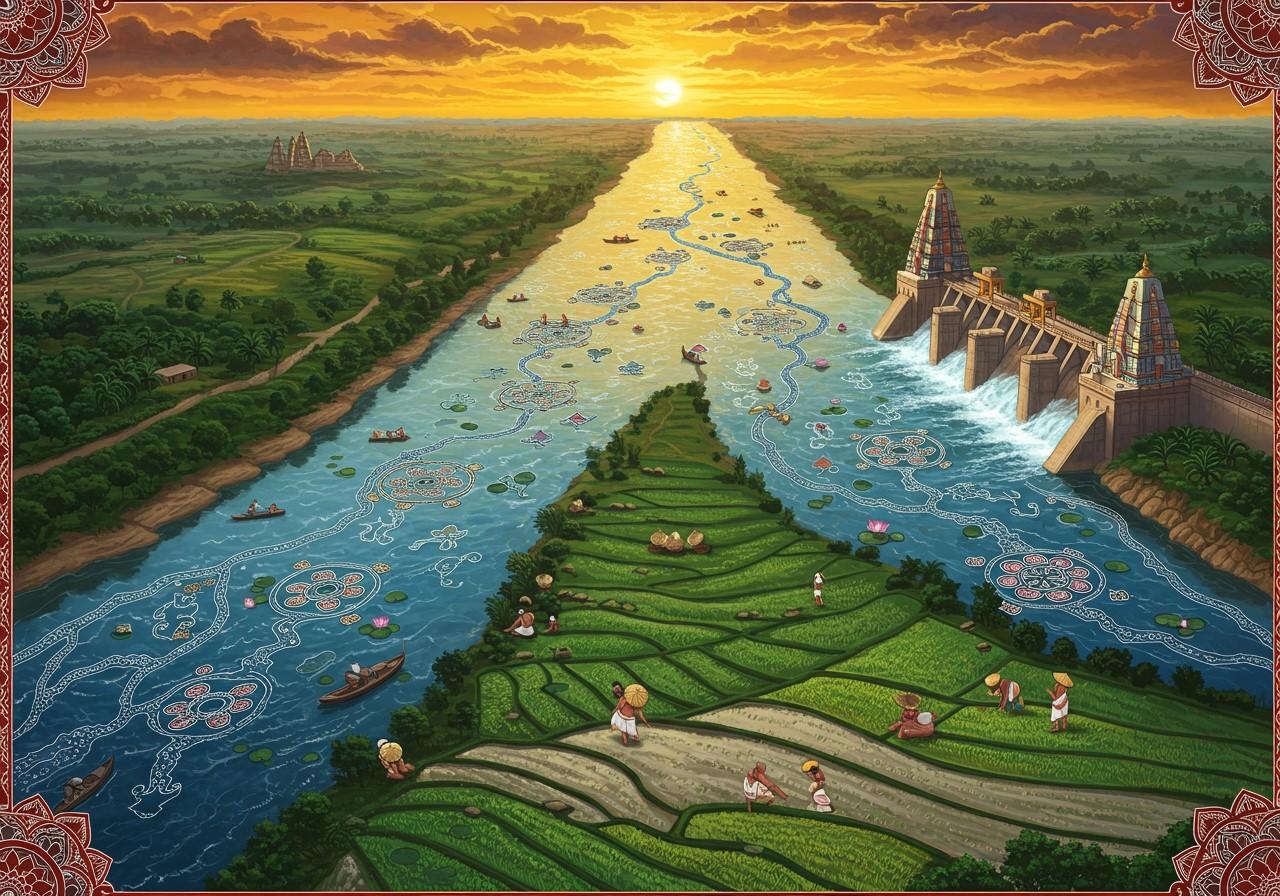
The Kaveri River, revered as the Dakshina Ganga (Ganges of the South), holds immense cultural and agricultural significance in southern India. Originating in the Brahmagiri Hill within the Western Ghats of Karnataka, this 765 km river journeys southeast through Karnataka and Tamil Nadu before gracing the Bay of Bengal. As the third largest river in the region, after the Godavari and Krishna, the Kaveri boasts a catchment area of approximately 81,155 km², nurturing life and spirituality along its course.
Geographical Course of the Kaveri
From its source at Talakaveri, Karnataka, the Kaveri traverses a diverse landscape, shaping the fertile lands of the Deccan Plateau and forming islands like Srirangapatna. Its journey culminates in a delta at Poompuhar, Tamil Nadu, where it merges with the Bay of Bengal. This extensive course sustains a rich ecosystem and provides water for crucial agricultural regions.
Tributaries of the Kaveri
The Kaveri’s might is amplified by several tributaries, each contributing to the river’s vitality. These include the Hemavati, Kabini, Bhavani, and Amaravati rivers.
Hemavati River
Born in the Western Ghats, the Hemavati joins the Kaveri near Krishnarajasagara. Its waters irrigate the farmlands of Karnataka, and the Hemavati Reservoir plays a crucial role in water management, especially during seasonal variations.
Kabini River
Flowing from Kerala into Karnataka, the Kabini merges with the Kaveri at the Krishna Raja Sagara Dam. This tributary is vital for the flourishing biodiversity of the Kabini Wildlife Sanctuary and supports agricultural practices in the region.
Bhavani River
Originating in the Nilgiri Hills, the Bhavani meanders through Tamil Nadu before uniting with the Kaveri. It serves as a lifeline for farmers, providing irrigation for fertile lands. The Lower Bhavani Project, an extensive irrigation system, effectively utilizes its waters for agriculture.
Amaravati River
The Amaravati River commences its journey in the Anamalai Hills and flows through Tamil Nadu. It is a key tributary, nourishing agricultural lands and contributing to the Kaveri’s flow. The Amaravathi Dam on this river plays a vital role in both irrigation and flood control.
Dams and Their Strategic Role
Several significant dams along the Kaveri serve multiple purposes, including irrigation, power generation, and flood control.
The Krishna Raja Sagara Dam, a masterpiece designed by Sir M. Visvesvaraya, stands as a testament to engineering ingenuity, storing water for irrigation and generating power, thereby significantly contributing to the agricultural economy. The Mettur Dam, one of India’s largest, regulates water flow to Tamil Nadu, ensuring a consistent supply during dry spells and mitigating flood risks during monsoons.
Water Management and Conflict Resolution
Water management in the Kaveri basin is a complex issue due to the competing demands of Karnataka and Tamil Nadu. Historical disputes have led to the formation of the Cauvery Water Management Authority, responsible for ensuring equitable water distribution between the two states.
Local communities have adopted innovative water conservation methods like rainwater harvesting and efficient irrigation techniques to address the challenges of changing climatic conditions. These practices reflect a deep respect for traditional water wisdom and demonstrate resilience in adapting to environmental changes.
Cultural and Religious Significance
The Kaveri is deeply embedded in the cultural and religious fabric of southern India. Revered as a sacred river, it is often referred to as the “Ganges of the South.” Festivals like Kaveri Sankramana celebrate the river’s purity and life-giving properties. Its essence is captured in literature, folklore, art, and spiritual practices.
Environmental Concerns and Conservation Initiatives
Despite its significance, the Kaveri faces environmental threats like industrial pollution and deforestation, exacerbated by the impacts of climate change. Governmental and non-governmental organizations are actively involved in restoration efforts. Community-led initiatives promote sustainable water use and habitat preservation, fostering a sense of responsibility towards the river’s well-being.
Poojn.in: Supporting Kaveri River Worship
Poojn.in, India’s leading store for cultural and religious goods, offers a wide range of products for devotees seeking to perform rituals associated with the sacred Kaveri River. Poojn.in provides authentic puja items sourced from trusted vendors, ensuring quality and customer satisfaction.
- Copper Kalash: Pure copper vessels for collecting holy water, essential for Kaveri River rituals. Find copper kalash here.
- Organic Turmeric and Kumkum: Essential for traditional river aarti ceremonies, symbolizing purity and auspiciousness. Explore organic puja samagri.
- Cotton Wicks and Pure Ghee Diyas: For evening ceremonies and prayers by the riverbank, creating a sacred ambiance. Shop for diyas and wicks.
For a complete selection of river puja items and expert guidance on ritual procedures, visit www.poojn.in. Poojn.in offers convenient home delivery across India with secure packaging. Special discounts are available for bulk orders during major river festivals or community events.
Conclusion
The Kaveri River, with its tributaries, dams, and profound cultural significance, sustains millions of lives. Its waters nourish the land, support biodiversity, and inspire devotion. Balancing traditional practices with modern water management is crucial for preserving this vital resource for future generations. Through collective efforts and respect, the Kaveri will continue to flow, a testament to India’s rich heritage and innovative spirit.
FAQs: Understanding the Kaveri River
Where does the Kaveri River originate, and where does it ultimately flow? The Kaveri River originates in the Brahmagiri Hills of the Western Ghats in Karnataka and flows through Karnataka and Tamil Nadu before emptying into the Bay of Bengal.
What is the role of the Krishna Raja Sagara Dam? The Krishna Raja Sagara Dam, designed by Sir M. Visvesvaraya, plays a crucial role in storing water for irrigation and generating hydroelectric power, supporting the agricultural economy.
Which are the major tributaries that contribute to the Kaveri’s flow? The Hemavati, Kabini, Bhavani, and Amaravati rivers are the major tributaries that contribute significantly to the Kaveri’s water volume.
Why is the Kaveri River considered sacred? The Kaveri River holds deep religious significance for Hindus, who revere it as the Dakshina Ganga or Ganges of the South. It is associated with various myths and legends and is central to several religious festivals and ceremonies.


